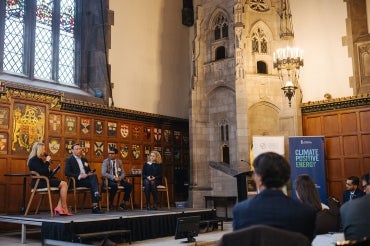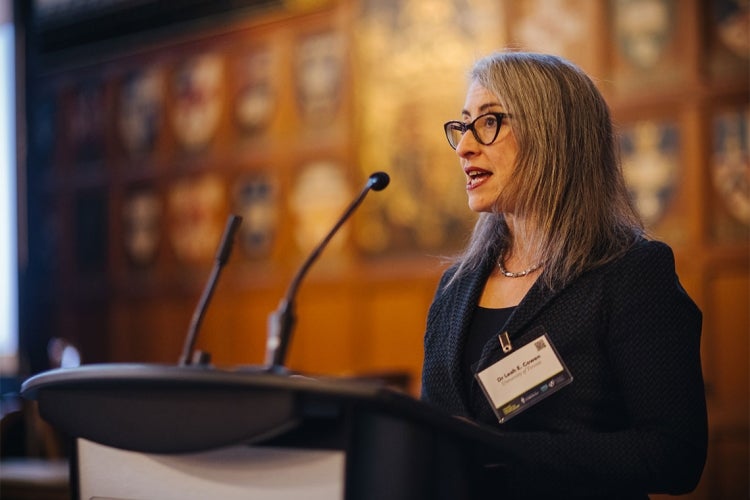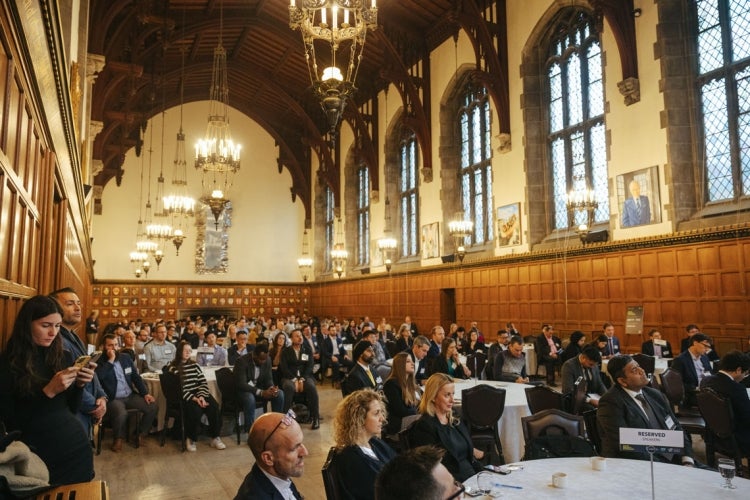Smart and clean growth conference draws industry, government leaders

(photo by Liz Beddall)
Published: December 4, 2023
From innovative clean technology to smart building standards, University of Toronto researchers are working with industry and communities to reduce emissions in infrastructure and transportation – and to support a cleaner energy grid.
That was among the takeaways from the inaugural Smart Growth Symposium, which recently drew more than 250 representatives from industry, academia and government to Hart House to showcase smart and clean technology solutions.
The event was co-hosted by the Ontario Chamber of Commerce and U of T’s Climate Positive Energy (CPE) initiative, an institutional strategic initiative that brings together more than 500 researchers and students across U of T’s three campuses to develop social, scientific, technical, economic and policy solutions that will help policymakers reach net-zero by 2050 and ensure an equitable energy transition.

“While Climate Positive Energy is working to solve global problems, it maintains a laser focus on local impact,” Leah Cowen, U of T’s vice-president, research and innovation, and strategic initiatives, said in her opening remarks.
“CPE is working closely with other groups across the university to create a climate positive campus by engaging researchers in projects that can be piloted right here at the university, with our campus functioning as a ‘living lab.’”
The Ontario government’s priorities, meanwhile, include balancing housing construction with environmental objectives and increasing green space in the province, said Andrea Khanjin, minister of environment, conservation and parks.
David Sinton, CPE’s academic director, said U of T has deep expertise in all the fields needed to help Canada achieve its climate objectives.
“The critical role of strategic initiatives like CPE is that we bring together those disciplines, and match teams with industry, government, and other partners to achieve those goals,” he said.

The symposium included several panels that examined the shifts taking place across various sectors, including:
- Building Smart: The building sector is increasingly adopting technologies – from digital twinning to smart energy monitoring to retrofits – to improve overall performance and efficiency. Dima Zreik, director of investments at the Canada Infrastructure Bank (CIB), spoke to the CIB’s Building Retrofits Initiative, which provides financing to decarbonize and improve the energy efficiency of existing buildings in both the public and private sector – including U of T’s Project Leap. Derek Goring, Northcrest Developments’ CEO, stressed that to adopt new technologies in the building sector, there must be shared standards on data governance, referring to his ongoing collaboration with the Centre for the Sustainable Built Environment led by Shoshanna Saxe, an associate professor in the department of civil and mineral engineering in the Faculty of Applied Science & Engineering.
- Advanced Mobility: Electric vehicles (EVs) are sparking change across the automotive supply chain. Brian Kingston, president and CEO of the Canadian Vehicle Manufacturers’ Association, noted the auto sector plans to spend nearly $1.2 trillion through 2030 to produce millions of EVs, along with the batteries and raw materials needed to support that production. For Kingston, a key challenge is ensuring EV demand since adoption sits at 13 per cent in Canada amid consumers’ concerns about the availability of charging infrastructure and grid capacity.
- Smart Energy Grid: With electricity demand from EVs and a growing population expected to double electricity demand by 2050, concerns about the power grid’s reliability have grown. This is why CPE is spearheading the Grid Modernization, Testing and Simulation Centre with the support of 55 partners, said Shatha Qaqish-Clavering, CPE’s director of strategy and operations. Led by Professor Ali Hooshyar, the Ontario-based, state-of-the-art facility will help small- and medium-sized enterprises commercialize green technologies and develop solutions to ensure Ontario’s grid remains safe and reliable.
Industry partners said the Grid Modernization, Testing and Simulation Centre will accelerate the adoption of new technologies.
“We’re very excited about this centre,” said Frank D’Andrea, Hydro One’s vice-president and executive lead, enterprise strategy and energy transition. “One way to offset affordability issues is to become innovative. We view U of T as a partner and are looking to test technologies, scale them, and bring them to utilities for adoption.”
“Before we implement anything onto the grid, we need to ensure it’s safe and resilient,” said Shitiz Agrawal, vice-president of power systems, sales and operations at Schneider Electric. “What’s unique about this centre is that it’ll provide real-time simulation and engages all ecosystem players.”
The collaborative approach adopted by the Grid Centre initiative is also evident in another effort led by CPE: the CANSTOREnergy project. The project, which recently received a $24-million grant from the federal government’s New Frontiers in Research Fund, involves researchers from 11 Canadian universities, led by Sinton, who are developing clean energy technologies tailored to meet the needs of two Canadian communities – one in Ontario and the other in the Yukon.
Whether the domain is transportation, housing, or energy transmission, all panelists agreed that the time for action is now.
Nolan Andres, chief of technology and innovation for Kindred Credit Union, said the existential threat of climate change is increasingly being met with a collaborative response — one that is "driving us closer together."



